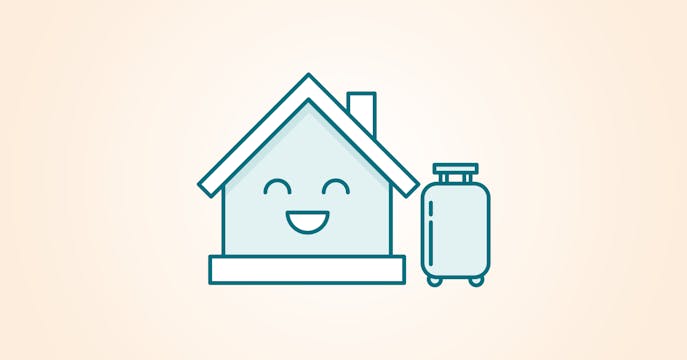Lowest Mortgage Rate in Canada. Starting from 2.49%
One mortgage to serve them all.
Multigenerational mortgages are starting to make sense for more Canadians who dream of home ownership.
Buying a home with family can help remove 'affordability' roadblocks (and come with other perks). Here's what's involved for your multi-family pre-approval.
Get a home the whole family can afford.
Let's be honest — multigenerational living and co-owning isn't exactly a new concept. But the pandemic disruption made many Canadians sit up and take notice:
- Homes are now a lot less affordable for the younger generation
- The older generation wants to be closer to their kids and grandkids
Home affordability has worsened.
According to the National Bank of Canada, housing affordability continues to deteriorate. For the first time since 1994, more than 50% of 'representative household' income is needed to service the mortgage of a typical home bought in Canada (May 25, 2022).
A multigenerational mortgage (at your best rate) can help overcome the roadblocks to affordability for both younger and older generations looking to attain equity in a home:
- Adult children striking out on their own, who have regular jobs or are starting a family, may not have a large enough down payment
- Starting salaries for younger employees may not allow budget room for a mortgage payment
- Young working parents may have childcare expenses that restrict their monthly budget
- Older parents may want to down-size, yet are concerned about high home prices and tight markets
- Adults of any age may be reluctant to move too far from family to afford a smaller mortgage

Advantages to owning a home with your kids (or your parents)
Sharing a mortgage between two or more family generations may bring home affordability within reach but may also come with other substantial perks for all involved:
- Pool resources for a bigger down payment to get a conventional mortgage (no insurance premiums)
- Share costs, including mortgage closing costs, monthly payments, utilities and maintenance expenses
- Benefit from living arrangements, such as childcare for younger parents, homecare for older parents, and other shared duties to further reduce costs and enhance quality of life
- Afford a bigger home or property size, or a more desirable neighbourhood
- Pool funds for home upgrades or better amenities
- Access a government tax credit for 'multigenerational' upgrades to save a little more (available starting Jan 1, 2023)
Example of a multigenerational home
Mom and Dad buy a larger home with their adult children (and a grandchild). They renovate a basement suite — to 'down-size' for a simpler lifestyle but still have a short commute (up the stairs!) to help with meals, childcare or to socialize with family. Their adult kids and their children occupy the main floor or more, and in turn, help them age in place for a comfortable retirement.
The kids pay a larger share of the mortgage payment, their parents pay for the upgrades — and all share utility and maintenance costs.
Your pre-approval for a multigenerational mortgage
Joint Tenant (vs Tenants in Common)
Typically, close relatives or extended family that want to share a home use a Joint Tenants mortgage — versus a Tenants in Common agreement (often used for a co-ownership mortgage).
A Joint Tenant agreement allows relatively straightforward, equal ownership shared between family members. Upon the death of a member, ownership is transferred to the remaining members who assume full mortgage responsibility, and the lender may require that they requalify for the mortgage.
Here's how your multigenerational pre-approval works:
1. Reside in the home or on the property. All parties who will be on the same mortgage must also be primary residents of the home.
2. All parties can be on the mortgage, though some restrictions may apply depending on the lender. Those with lower credit (like a beacon score under 600) can likely still be on the mortgage but won't have to use their income to qualify if the other parties involved have stronger applications.
3. Each mortgage applicant is qualified separately. Each person on the mortgage is considered fully responsible for the mortgage and is subject to lender qualification.
4. Know your down payment amount. Pooling funds for a bigger down payment can help you qualify for more house or reduce the amount of your mortgage loan. Have your down payment sources tallied and ready for your expert broker.
5. Guarantors. A person residing in the home can be on the mortgage as a guarantor but won't be listed on the title.
6. Co-signers. Someone who will not be living in the home, but has strong qualifying factors, may be able to co-sign for the mortgage (for example, a parent or an aunt) and won't be added to the title.
What happens if someone leaves?
Move out, leave equity. For example, Mom and Dad decide they want to move but not take their share of the equity (leaving it for their kids still on the mortgage). A 'change of covenant' releases a person from the mortgage and nothing else changes — the remaining members on the mortgage now have full responsibility for the loan (fees may apply).
Move out, take equity. If someone leaves and wants their share of the home's equity, it triggers a refinance (assuming everyone else is staying). Those remaining would need to requalify, and an appraisal will be needed to confirm the home's value (fees may apply). If the equity-payment amount is within lender guidelines, the refinance would include the amount of equity to be paid out, with the new mortgage now the responsibility of the remaining members.
In the event of a death. With a joint mortgage, ownership and mortgage responsibility are transferred to the remaining owners — who may need to requalify for the mortgage (if they decide not to sell). The name should be removed from the mortgage and title to prevent mortgage fraud (fees may apply).
Legal arrangements. Even with a joint mortgage, family members may decide to have further agreements drawn up — to facilitate equity payout if someone leaves, if other beneficiaries may be involved for equity payout, or to outline specific financial responsibilities.
All family hands on deck! Sharing a cottage is also a growing trend.
Cottage and vacation homes are pricier than ever. Some families are taking it in stride by sharing the financial load for a more affordable getaway. Multigenerational cottage or vacation homes offer a way to afford red-hot vacation regions or to get a more desirable vacation home that might be unattainable with only one family's income.
It makes sense — many families come together to spend their vacation time, so why not pool resources to pay less overall for a place everyone can enjoy? In this case, as a secondary home purchase, stricter lender requirements and qualifications may apply.
Can we be family, too? But the kind that helps you get a better rate and mortgage.
If you're thinking about a family home shared with more family, we can help you bring it all together in one mortgage.
Our friendly, expert brokers can get your best rate (for which you qualify), and take care of all your pre-approval details to find out if a multigenerational mortgage will work for you. Then, when you have the home that works, we'll help you finalize your mortgage right down to the flexible options that will save you more later if you need a change.
Need to refinance? We're here for that too. Anywhere you are in Canada — online, over the phone or at a store location.
Our TNM family is here to help yours.
Want to know more about our better rates?

Proof that our rates are lower.
Our rates are 0.18% lower on average compared to everyone else. Prove it? Okay!

All the ways to save on your mortgage.
Here are 12 great tips to help calm your (mortgage) budget woes.

Newcomers to Canada
New to Canada, eh? We're a friendly face for expert mortgage help.

